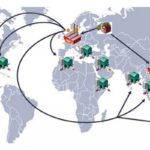 The last few years has seen the forecasting profession come under fire, as politicians have poured scorn on the inability of experts to predict the future with complete accuracy. Whilst the accusation is largely nonsense that gives populist politicians free reign, the profession has nonetheless been under pressure to up its game.
The last few years has seen the forecasting profession come under fire, as politicians have poured scorn on the inability of experts to predict the future with complete accuracy. Whilst the accusation is largely nonsense that gives populist politicians free reign, the profession has nonetheless been under pressure to up its game.
New research from Washington University in St. Louis proposes a supply chain model to forecast the effect of tariffs the like of which the Trump administration recently imposed on steel imports. Such tariffs are often imposed in the belief that the industry they seek to protect operates in a kind of vacuum. The reality is that it has a ripple effect throughout the supply chain however.
What’s more, these ripples don’t just transpire domestically, as the Chinese government imposed their own retaliatory tariffs on numerous American goods, which in turn caused trade to shift to South America.
“Suddenly, they realize there’s another sourcing opportunity, and they seize the opportunity,” the authors explain. “Tariffs have short-term benefits and long-term implications that are frequently quite unpleasant. In the long term, firms adjust to the new realities.”
Trump trigger
The research was triggered by the tariffs introduced by the Trump administration to ostensibly protect US steel and aluminium manufacturers from foreign competition. The repercussions were not quite as straight forward however, as they spread out from the steel and aluminium sector to touch the entire supply chains those are part of. As such, it’s vital that policy makers are aware of the possible side effects of their actions.
“Companies go where they see the opportunities and the growth,” they explain. “We are moving towards regional supply chains, and in many cases that might be a desirable supply chain outcome. Shorter and market-focused chains are often argued as agile and lean. But tariffs might not have been the best way to end up there, and they may have caused competitive headaches for some of the US companies.”
To do this, they constructed a number of models to try and take into account the numerous factors and variables within the supply chain. For instance, they incorporated where the supplier of raw materials was located in relation to the manufacturer of the finished goods.
The paper is littered with examples of how tariffs have affected particular companies and industries. For instance, they reveal how Harley-Davidson suffered from higher production costs at their manufacturing plants in the United States, plus additional costs associated with shipping the motorcycles to Europe as a result of retaliatory tariffs. In the end, they shifted some production to Europe to avoid the costs.
The model aims to accurately predict what happens, taking into account the complexity of industries with supply chains spread across the globe.
“We can tell you in stories after the fact some of the impact, but we need a model that predicts the direction of change and explains the stories,” the researchers explain. “What are the factors you have to think about so you can predict the move before it happens—rather than being a Monday morning quarterback?”